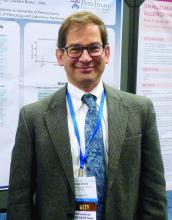SAN FRANCISCO – Clinicians safely used epicutaneous immunotherapy to resolve eosinophilic esophagitis in children and teens secondary to milk consumption in a placebo-controlled, pilot study that included 20 patients.
Following the randomized phase of the study, all 19 patients who continued to participate began an 11-month open-label phase of epicutaneous immunotherapy to milk. At the end of this open-label phase, nine patients (47%) followed in this phase showed a substantial cut in their eosinophilic esophagitis (EoE) response to milk, with fewer than 15 eosinophils in a high-powered field, said Jonathan M. Spergel, MD, chief of the allergy section and Stuart E. Starr Chair of Pediatrics at the Children’s Hospital of Philadelphia, while presenting a poster at the annual meeting of the American Academy of Allergy, Asthma, and Immunology. An immunologic response of this sort would likely correlate with substantial clinical benefit.
“I’m happy with a 47% response,” Dr. Spergel said, adding that the responding patients “tolerate milk without symptoms, and there is really no risk” from this form of immunotherapy, which produced no serious adverse effects and caused 1 of 15 patients to stop treatment because of a treatment-related effect during the randomized phase. The most common adverse reaction was gastrointestinal symptoms, but these were just marginally more common among patients on active treatment than in control patients.
In contrast, oral immunotherapy with milk has been ineffective in children with an EoE milk reaction, and results from subcutaneous or sublingual immunotherapy for this form of milk allergy haven’t been reported, he said. The most common, current approaches to managing EoE from milk in children are either milk avoidance or treatment to reduce inflammation.
The epicutaneous approach “uses substantially lower dosing [micrograms vs. milligrams], avoids oral allergen ingestion, and may have a more advantageous adverse event profile and better adherence than other therapies,” according to a recent report that tested epicutaneous immunotherapy for peanut allergy in a phase 3 trial with 356 children (JAMA. 2019 Feb 22. doi: 10.1001/jama.2019.1113). The Viaskin Milk system tested in the current milk study involves placing a disc coated with 500 mcg of lyophilized milk protein on the skin for a gradually increasing number of hours daily until the disc is worn continuously, with daily changes of the disk. On the skin, the protein on the disk interacts with epidermal Langerhans cells to trigger desensitization.
The Milk Patch for Eosinophilic Esophagitis (SMILEE) study enrolled 20 patients at Children’s Hospital aged 4-17 years old and had milk-induced EoE, and randomized 15 to receive active epicutaneous immunotherapy to milk and 5 to receive placebo treatment. The protocol called for 9 month of epicutaneous immunotherapy without any milk exposure, followed by 2 months of continued treatment coupled with at least 240 mL of milk consumption daily. At the end of 2 months the researchers performed an esophageal biopsy on each patient to determine eosinophil density in the tissue. The study’s primary endpoint was the number of eosinophils in a high-powered field.
During the randomized phase, 8 of the 15 patients assigned to active treatment and 3 of 5 patients assigned to the placebo arm had violations of the treatment protocol, the diet protocol, or both. A per protocol analysis that focused on the seven actively treated and two placebo patients who adhered to the protocol showed a mean eosinophil count of 26 cells in patients on active treatment and 95 cells among the controls, a statistically significant difference. However, for the intention-to-treat analysis, which included all 20 enrolled patients, the primary endpoint showed no significant difference in eosinophil counts between the two study arms.
Although Dr. Spergel said that he was not aware of the developing company’s plans for further study of epicutaneous milk immunotherapy, from a scientific standpoint the next step should be a phase 2 or phase 2/3 trial for safety and efficacy. EoE was historically considered a rare disease, but a 2015 review of the condition called it “one of the most common conditions diagnosed during the assessment of feeding problems in children” (New Engl J Med. 2015 Oct 22;373[17]:1640-8).
The study was funded by DBV Technologies, which is developing the epicutaneous immunotherapy system. Dr. Spergel has been a consultant to and has received research funding from DBV Technologies.
SOURCE: Spergel JM et al. J Allergy Clin Immunol. 2019 Feb;143[2]:AB430.


